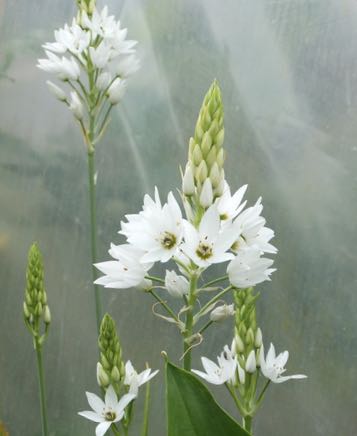
Amongst the benefits a glasshouse offers can be year round flowers for cutting. Cut flowers are more expensive to purchase than most fruits and vegetables so really deserve some attention. And one of the best cut flowers for sheer endurance once cut is the Chincherinchee.
Ornithogalum thyrsoides is a bulbous plant of the Lily family from South Africa introduced here in the eighteenth century despite it being tender. It soon became popular as each bulb throws up to three two foot spikes (racemes actually), each with three dozen beautiful white stars opening over a month or even more in late spring or summer.
Other than being tender Chinchirinchees are not difficult to look after. Neither prone to pests nor diseases these prefer a free draining sandy leaf mould rich compost and full light.
You can buy bulbs for instant results or start from seed which will take four years or so to bloom. Small bulbils can be detached and grown on to bloom in just two years.
Ideally pot your bulbs in barely moist compost in autumn and only water once growth appears. During the growing season water and feed regularly but lightly, more heavily as they come into bloom. Cut the spikes as the first bud opens.
The strange sounding Chinchirinchee is their South African name where it means the sound the wind makes as it rubs their dry stems standing in a bed against each other. This indicates a period of drying weather after flowering and so once the flowers have finished and the leaves have withered dry off their compost to give them a break.
If the summers are not bright and warm bulbs may deteriorate and flower less enthusiastically over successive years. However as these’re inexpensive you may simply purchase new bulbs and discard the older.
Collectors easily find about forty species and varieties, most with flowers in white or yellow, another sixty or more are known but out of cultivation, and some quite curious.
Ornithogalum caudatum, also from S. Africa is the False Sea-Onion, a big fat bulb grown atop the compost with strap like leaves it was often kept on indoor windowsills for it was also known as the Healing onion with the leaves used medicinally against infections. O. saundersiae, another from S. Africa, is the Giant Chinkerinchee which can reach six feet with it’s leaves, more with the flower spike. The beautiful and fragrant O. arabicum was Parkinson’s Great Star Flower of Arabia when first introduced.
There are even hardy species, O. umbellatum, Star of Bethlehem, is another from the Middle East, known in the Bible as Dove’s Dung as perversely the bulbs were considered good eating after boiling.










